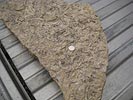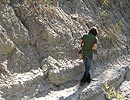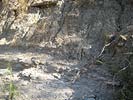|
The Geology of Texas - Vol. 1
DENTON FORMATION
Nomenclature. -- The Denton marl of Taff (1575, p. 272), the
Marietta beds of Hill (788, pp. 328-329), and the Denton sub-group of Hill
(803, pp. 271-273), apparently refer to the same strata. The type locality
by implication is on Denton Creek, west of Justin, Denton County, where
Taff records a thickness of 38 feet.
Facies. -- In central Texas, the formation is a marl, shell marl,
and shell aggregate, with shelly and limestone seams. In the Fort Stockton
and Kent sections, a rudistid limestone caprock is referred to the Denton.
Areal outcrop; local section. -- Taff included the Denton, Weno, and
Pawpaw formations in his "Bokchito" in southern Oklahoma. The
lower 73 feet is recorded (Bullard, Okla. Geol. Surv., Bull. 33. page 36,
1925) as a clay with a thin medial sandstone, and some or possibly all of
it is Denton. In Marshall County (174, p. 36) 45 to 55 feet is recorded,
and in Bryan County 46 feet. In Grayson County (844), p. 4), the Denton is
45 to 52 feet thick. Down the strike the following thicknesses are on
record: Cooke County, 45 to 60 feet; Denton County, 25 to 35 feet; Tarrant
County, 25 feet; Johnson County, 20 to 25 feet; McLennan and Bell
counties, about 5 feet; Travis County, about 5 feet. At Fort Stockton the
beds of the middle rudistid caprock, assigned to the Denton, are about
38.5 feet thick, but the basal part of this may be Fort Worth Limestone.
At El Paso the Denton is a marly, nodular limestone about 50 feet thick
(upper part of Bose's subdivision 5).
This is one of the most widespread horizons in the Washita, and some
representative of its shell horizon may be found in the southern limy
fades of the Georgetown. In the Red River region, Denton lithology is
distinguished by these features: the body of the formation is clay or
marl; the base, transitional to the Fort Worth limestone, is more
calcareous, and locally has thin limestone seams; near the middle of the
formation there is a persistent, thin, fissile, laminated, ripple-marked,
light-colored sandstone, which breaks into large slabs and covers the
lower clay slopes; and at the top of the Denton there is a Gryphaea
washitaensis shell aggregate, shell seams, or shelly limestone, one
foot or more thick.
In Bryan County, Oklahoma (174, p. 37), the sandstone, brownish-yellow,
hard, thinly laminated, ripple-marked, one foot thick, overlies 26 feet of
basal Denton clay. In Grayson County, the yellow-brown, thinly laminated,
ripple-marked sandstone is 20 to 30 feet and exceptionally more, above the
base of the Denton. In Hampton Hollow, Cooke County (177, p. 35), the
Denton consists of 67 feet of clay, with a 1.5 foot ripple-marked
sandstone 30 feet above the base. To the south the sandstone shortly
disappears. In Denton County the upper 6 feet of the formation is Gryphaea
shelly limestone and shell marl, and the remainder is clay. In Tarrant
County the medial sandstone is absent; the base of the formation above the
thin limy seams, transitional to the underlying Fort Worth limestone,
contains a small thickness of sandy marl and sandy ledges, followed by
blue shelly clay; the top contains two harder Gryphaea shell strata
in a very shelly clay. In Bell County the thinned Denton is a uniform
shelly marl, which forms a connecting slope between the top of the Fort
Worth limestone, exposed beneath as a terrace or narrow shelf, and the
overlying Weno limestone. This marl break is distinguishable generally in
the topography. Farther south, as the terranes lose the terraced
expression characteristic of north-central Texas, the Denton outcrops
become very narrow and inconspicuous. At Mexia, the Denton, Weno, and
Pawpaw are very reduced in thickness. In some wells in the outcrop
counties, the Denton may be recognized from logs; apparently on passing
gulfwards it rapidly disappears as a marl.
In Trans-Pecos Texas, Denton is present in its usual facies at El Paso,
Kent, and Sierra Prieta. At Cerro de Muleros it forms the upper part of Böse's
subdivision 5. and is a marl and nodular dark bluish-gray, soft limestone,
containing a fauna of beautifully preserved echinoids (Pyrina, Phymosoma,
Holectypus, and others). This echinoid level appears at Kent, where
the Denton forms a cap rock of nodular, non-rudistid limestone. At Fort
Stockton the upper part of this limestone cap rock is in the rudistid reef
facies and contains Eoradiolites n. sp., caprinids, Chondrodonta,
reef Nerinea and Pecten, corals, sponges, Actaeonella,
and other distinctive fossils. The same features occur near Gap Tank and
in eastern Pecos County.
Paleontology. -- The top of the Denton is a persistent mass of shell marl
and shelly limestone, becoming almost entirely shell marl in south-central
Texas. It contains innumerable Gryphaea washitaensis (all growth
stages), which are present but less abundant lower in the Denton, and Alectryonia
cf. carinata, Leiocidaris hemigranosus (plates and spines), Heteraster,
and some less frequent, wide-ranging Washita species. One of the most
prominent features is a great development of the large echinoid,
Macraster, represented by several species. Several kinds of Pervinquieria
occur, one of which (P. aff. kiliani) may prove to be a
restricted zone fossil. Numerous ammonites (Pervinquieria and
others), preserved as pyritic dwarfs, occur in the Red River section.
Rarities are Rhabdocidaris n. sp., Turrilites spp., "Vola"
[Lima?] catherina Cragin, and some ammonites. The Denton in the clay
facies is notable for small crustacea. Miss M. J. Rathbun has kindly
listed the following from Bureau collections!
|


